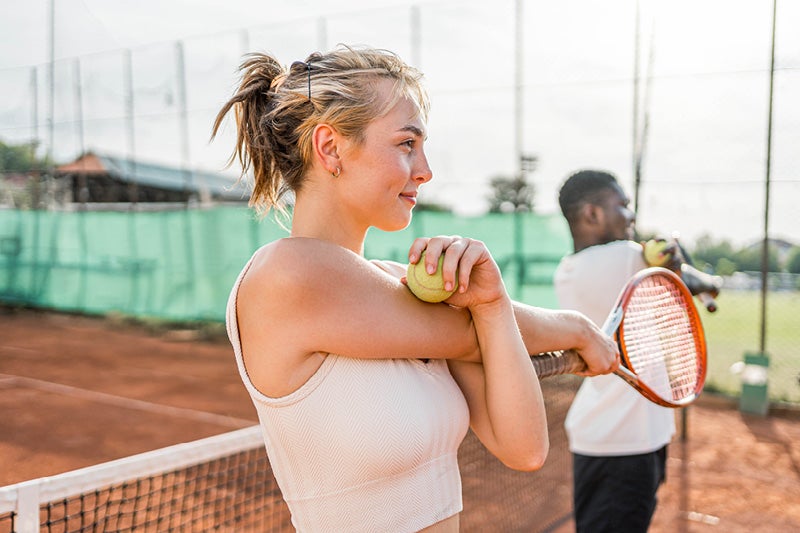Thrower’s shoulder: How to recognize, recover from and prevent shoulder injuries
August 13, 2025Categories: Bone and Joint

Overview: Shoulder injuries can be a setback, but with the right knowledge, support and care, they don’t have to sideline your game. Learn how to recognize shoulder injuries and discover expert recovery and prevention tips from a physical therapist.
Whether you're a casual ball player, a high school pitcher or the parent of a young athlete, understanding shoulder health is important in any sport that involves throwing. Baseball, softball, tennis and other overhead sports place unique and repetitive stress on the shoulder joint.
Shoulder injuries are most common in pitchers; however, throwing-related injuries can happen to anyone. Here’s what you need to know about shoulder injuries, when to seek help and tips for recovery so you can build a stronger throwing arm and prevent future injuries:
Types and causes of shoulder injuries in throwers
It’s important to understand and recognize common shoulder injuries that can result from throwing, so you can seek proper care. Common injuries include:
- Rotator cuff strains and sprains: The rotator cuff is a group of muscles and tendons that stabilize the shoulder. When they become overused, strains and sprains can occur, causing pain or discomfort. Full tears in the rotator cuff, although possible, are not commonly a result of over-throwing.
- Labral tears: The labrum is a ring of cartilage that surrounds the shoulder socket and helps keep the joint stable. When the labrum is torn, the shoulder can become unstable, leading to symptoms such as pain, a clicking sound and a sensation of the joint catching or locking. If the injury is severe, surgery might be required.
- Growth plate injuries (Little League shoulder): These injuries are unique to growing athletes between ages 8 and 15 and caused by stress on developing bones. If not managed properly, they can lead to long-term issues.
Most of these injuries are due to overuse and throwing past muscle fatigue. When athletes don’t allow the shoulder enough time to rest, they put themselves at risk of injuries.
Explore other shoulder injuries
When to see a doctor and tips for recovery
It’s recommended you consult a physical therapist when you begin to feel shoulder pain, especially if the pain persists when you throw. Your physical therapist (PT) will work with you to develop a personalized recovery plan based on your injury, age and how long you’ve been throwing.
In addition to seeing your PT, here are some general tips to keep in mind when you’re recovering:
- Immediately rest from throwing; you don’t want to worsen the injury.
- Apply ice and take over-the-counter anti-inflammatory medications to reduce swelling and pain.
- Once your pain has decreased, you can start to introduce gentle mobility movements. Try to avoid overhead or high-stress movements early on.
- Follow your PT’s recovery plan to help strengthen and stabilize your shoulder muscles.
- Take a gradual approach to throwing again, jumping back in too fast and too hard will just lead to more injuries.
Prioritizing rest and recovery will help you get back into the game – sooner rather than later! Remember, your condition is not getting better after a few days it’s important to see a medical professional for further evaluation.
So, how can athletes prevent shoulder injuries?
To reduce or prevent shoulder injuries, especially in young athletes, Karl Stratman , MercyOne Genesis Davenport Physical Therapy and Sports Medicine, suggests taking time off full effort throwing during the off-season and playing multiple sports. He explains that playing other sports (like basketball or soccer) uses different muscle groups, giving your shoulder time to recover.
Stratman also emphasizes the importance of full-body strength training:
“Only about 15 to 20% of the exertion for throwing comes from the arm/shoulder. The other 85% is done with the lower extremities and the core. So, a good training program not only involves the rotator cuff and the muscles around the scapula, but also the hips, quads, abdominals and glutes.”
With thoughtful training and recovery strategies, you can stay healthy and perform at your best in the long term.
Athletes! Learn how to also prevent foot and ankle injuries
Getting back in the game
Shoulder injuries can be a setback, but with the right knowledge, support and care, they don’t have to sideline your game. Working with a physical therapist, following a well-rounded training plan and giving your body the rest it needs are all key to keeping your throwing arm strong and healthy!
Learn more about MercyOne physical therapy
This blog was medically reviewed by MercyOne Provider.
